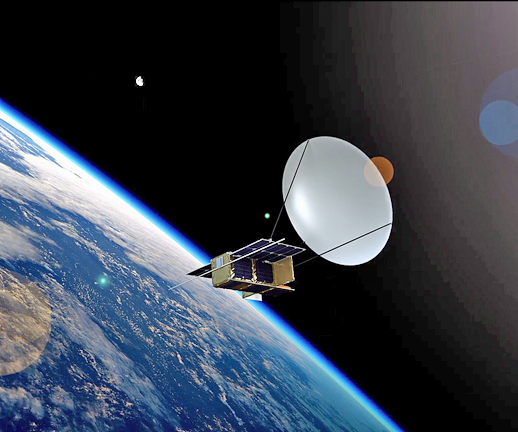
Enabling a new era of High-Throughput Nanosats (HTNs), NSLComm will deploy a unique satellite that takes advantage of its one-of-a-kind expandable and flexible spacecraft antenna to offer data rates up to 100x more than current nanosats.
Designed to accommodate the deployment of a non-rigid reflector that is bigger than any other antenna, the NSLSat-1 will deliver unheard of data rates for a nanosatellite and supercharge an industry “stuck” in narrowband communications.

Artistic rendition of NSLSat-1, courtesy of NSLComm.
Currently, nanosats offer less than 10 Mbps in LEO and mainly provide Earth Observation (EO), science experiments or other non-communications services. NSLSat-1, however, will deliver high-capacity footprints up to 1 Gbps and elevate LEO capabilities for a wide range of applications from narrowband to end-to-end constellations facilitating robust commercial and government applications.
NSLComm’s reflector folds up into just 2U (two liters) of space inside a specially designed nanosat and, once in orbit, it pops out to an unparalleled size that translates into super high bandwidth. In addition, NSLSat-1 incorporates a flexible subreflector that optimizes and shapes the antenna’s footprint to ensure payload flexibility that can change on the fly while deployed in LEO orbit.
NSLSat-1 offers the following advantages over current nanosats:
- Supercharged bandwidth with 100x throughput
- Adaptive on orbit footprint control
- Significantly lower stowed mass and volume
- The lowest price per bit to the end user
- Fast market growth with low barrier to entry
Raz Itzhaki Tamir, the CEO of the company, stated that the firm's overall vision is to provide affordable satellite communications. This new nanosat combines innovative, lightweight technology to ensure high-throughput technologies that offer a limitless variety of broadband applications. There is so much opportunity in this space and we want to facilitate low-cost opportunities for both commercial and government applications and constellations in both LEO and Geosynchronous Earth Orbit (GEO).

